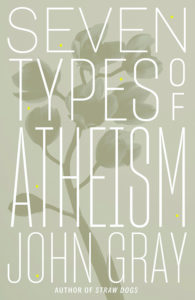Seven Types of Atheism

BY JOHN GRAY
FARRAR, STRAUS AND GIROUX, 2018
176 PP.; $25.00
The philosopher Ludwig Wittgenstein contended that religion has no single essence and that religions are best understood as extended families, in the sense that they display recognizable similarities but have no identifiable common element. This perspective guided William James in his classic work, The Varieties of Religious Experience (1902). What British historian of ideas John Gray convincingly demonstrates in his new book, Seven Types of Atheism, is that atheism is equally lacking in essence and that it also displays great diversity. More contentiously, Gray maintains that many forms of atheism are deeply indebted to the religions they strive to reject, amounting in some cases to little more than sublimations of religious impulses.
Because the meanings of religion and atheism alter with historical and geographical context, both terms are resistant to all but the broadest definitions. For Gray, religious ideas and practices aim to “make sense of the human passage through the world” and to “bestow some more-than-human significance on lived experience.” Attempts to formulate a more detailed definition would only result in the inclusion of some recognized religions at the cost of excluding others. It’s not possible, for example, to insist that religion requires a creator-god. As Gray puts it, “[r]eligion is universal, whereas monotheism is a local cult.” Nor can a definition of religion stipulate belief in the existence of an immortal soul, which is absent from many religious systems.
Gray’s working definition of an atheist is “anyone with no use for the idea of a divine mind that has fashioned the world.” In these terms, atheism merely denotes the rejection of a creator-god. This enables Gray to conclude that atheism and monotheism are two sides of the same coin. Furthermore, since many religious traditions have no conception of a creator-god, atheism doesn’t imply a wholesale rejection of religion. Indeed, from Gray’s perspective, Buddhism, which has no conception of a supreme being, can be called “an atheist religion.” And so, proceeding from his limited definition of atheism, Gray has identified seven currents of atheist thought throughout history.
He begins with the New Atheism that emerged in the first decade of the twenty-first century. This is the form of atheism for which Gray has the least regard. To date, the leading lights of the New Atheist movement are Richard Dawkins, Daniel Dennett, Sam Harris, and the late Christopher Hitchens. Gray wants to dismiss the New Atheism as “a tedious rerun of a Victorian squabble between science and religion” and as “a media phenomenon best appreciated as a type of entertainment.” What the New Atheists peddle is, for Gray, merely a reheated nineteenth-century positivism, according to which the observation and quantification of sense phenomena constitutes the only true knowledge. From a positivist viewpoint, religion is simply an erroneous theory of the cosmos, and one that has been superseded by science.
Gray argues that this is a misunderstanding of the nature of religion and its role in history and society. “Religion,” he writes, “is an attempt to find meaning in events, not a theory that tries to explain the universe.” The Genesis story, for example, should not be read as a primitive account of the origin of species but as a “mythical imagining of the ambiguous impact of knowledge on human freedom.” Contemporary biblical literalists aside, this has long been well understood within the Judeo-Christian tradition: in the first century, the Jewish philosopher Philo maintained that Genesis should be interpreted as allegory and, in the fourth century, St. Augustine argued much the same in an unfinished work. So, for Gray, the New Atheism attacks religion as a negated hypothesis, whereas it’s not a hypothesis at all.
The originator of positivism, French thinker Auguste Comte, attempted to develop a religion of humanity—an idea first advanced by his mentor Henri de Saint-Simon. This marks the origin of secular humanism, Gray’s second type of atheism. Secular humanists displace God with a conception of a common humanity that gradually uses its rational powers and cumulative knowledge to achieve its shared goals in a process of historical amelioration it terms “progress.” Among the leading currents of secular humanism, Gray identifies the Marxist interpretation of history, the rationalist liberalism of John Stuart Mill, Nietzschean ethics, and the radical individualism of Ayn Rand.

Gray insists that the humanist conviction that we are a species in control of our own destiny is dangerous and is, at the very least, a quasi-religious illusion. (Source: Wikipedia)
Provocatively, Gray interprets secular humanism as nothing more than a transmutation of the Christian belief of salvation in history, and he has two fundamental problems with it. First, he rejects the notion of a common humanity with a universal history, and he maintains that any such notion is an invention of Christianity. In the classical world, he points out, humanity was thought of as existing in separate civilizations, each with its own distinctive history. Second, Gray is impatient with what he calls the “unending chatter about progress,” an idea he believes to be “a secular avatar of a religious idea of redemption.” He accepts that there is meaningful progress in science and technology, but not in the spheres of ethics and politics, where evils are overcome only to return in new guises: slavery is abolished, but returns as human trafficking; torture is repressed, but resurfaces as enhanced interrogation; imperialism comes to an end, but revives itself as liberationist regime change; and so on.
Though Gray accepts the reality of scientific progress, he shows that science can itself be elevated to the status of a religion, and this is his third type of atheism. The replacement of divine revelation with scientific inquiry as the source of ultimate knowledge began in the Enlightenment, and science became entrenched in its new position after the Darwinian revolution. But human evolutionism, the illegitimate offspring of Darwinism, applied natural selection to the interpretation of human development.
The illegitimacy of human evolutionism lies in its conflation of evolution with progress. This confusion underlay Herbert Spencer’s efforts to interpret human society in terms of “the survival of the fittest.” It is present in Julian Huxley’s use of natural selection to support his ideas of innate racial inequalities between humans, and also in H.G. Wells’s prediction of a future in which humanity would be ruled by a scientific elite.
Today, the most radical expression of science as religion is transhumanism, according to which human beings consist essentially of a consciousness that they can first encode and then upload to cyberspace, thereby achieving immortality. While American tech mogul Ray Kurzweil enthusiastically advances these ideas in The Singularity is Near (2005), Israeli historian Yuval Noah Harari explores, in Homo Deus (2017), the risk a class of super-empowered “transhumans” would pose to the parent species. For Gray, such nightmare scenarios are what inevitably comes of deifying science.
Gray finds similarly false answers to perennial human dilemmas in ideology, or what he terms modern political religion—his fourth type of atheism. For the most part, the ideologies that have shaped our contemporary world from the French Revolution onward have been avowedly secular, but Gray contends that they’re really manifestations of Gnosticism and millenarianism drawn from the Christian tradition. Gnosticism was an early Christian heresy positing the possibility of human redemption through the acquisition of knowledge. This appears in ideology as the secret of history, whether it be Marx’s class struggle or Francis Fukuyama’s neo-Hegelian concept of history as the unfolding of individual freedom. Deriving from the Book of Revelation, millenarianism is the belief that Christ’s Second Coming will usher in a thousand-year messianic kingdom. Its ideological counterpart is the apocalyptic social transformation that brings human conflict to a final conclusion (i.e., Marx’s communist revolution or Fukuyama’s “end of history”).
Gray’s fifth form of atheism is misotheism, or a hatred of God as the enemy of humanity. This is a strange inclusion because to hate God is to concede God’s existence, which is the negation of Gray’s own definition of atheism. Perhaps the ultimate misotheist is the Marquis de Sade, whose confused philosophy Gray satisfyingly demolishes. Sade renounced God in favor of the divinity of nature, which he believed himself to be celebrating through sexual license and cruelty. But, asks Gray, “if everything human beings do is natural, how can religion be singled out as being contrary to Nature?”
Gray writes much more sympathetically about his final two types of atheism. He identifies an atheism that has no concept of progress, and his model example is the Spanish-born American philosopher George Santayana. Santayana declared his piety to the universe and saw all gods as human creations designed to serve human interests. A disciple of the ancient Greek Epicurean philosopher Lucretius, he unambiguously denied the reality of progress in history and put in its place a conservative emphasis on the refinement of particular extant ways of living. Gray also places Joseph Conrad in this category, drawing on the severe skepticism about the improvability of human nature that Conrad displayed in Heart of Darkness (1899) and the short story “An Outpost of Progress” (1897).
Finally, Gray identifies what he terms an atheism of silence. The work of the nineteenth-century German philosopher Arthur Schopenhauer is Gray’s starting point in his discussion of this subtle concept. Gray presents Schopenhauer as the ultimate anti-Gnostic: neither human knowledge nor the human will can make sense of history, which consists of drift, not direction. Thinkers like Friedrich Hegel who believed that history could be directed were simply repackaging Christian theodicy. An atheism of silence can also be found in negative theology, according to which God may very well have created the world, and may even pervade it, but no positive knowledge of God is possible.
Gray’s views on atheism are to be understood in the context of his broader thinking. As one of Britain’s most prominent and respected public intellectuals, his views are somewhat fluid, as can be seen in his shifting political allegiances. A Labour Party supporter in his student days, he briefly became a Thatcherite before renouncing neoliberalism and globalization as secular religions in his important book, False Dawn (1998). He then endorsed Tony Blair’s New Labour experiment in its short communitarian phase, before Blair was converted to a noxious cocktail of neoliberalism and American neoconservatism, leading to what Gray successfully predicted would be the disastrous invasion of Iraq. Today, he espouses a cautious “green conservatism.”
The unifying themes underlying these gyrations are his anti-Enlightenment skepticism and his resolute anti-utopianism, set out in other books such as Straw Dogs (2002) and Black Mass (2007). Gray insists that the humanist conviction that we are a species in control of our own destiny is dangerous and is, at the very least, a quasi-religious illusion. Though not a man of faith himself, Gray urges us to seek counsel in the myths and allegories of religion rather than in the axioms of rationalist philosophy.
Seven Types of Atheism is impressively erudite, clear, and accessible, and it offers controversy and provocation from start to finish. It effectively demolishes the binary juxtaposition of religion versus atheism, and it will prove a stimulating read for both believers and nonbelievers alike.
